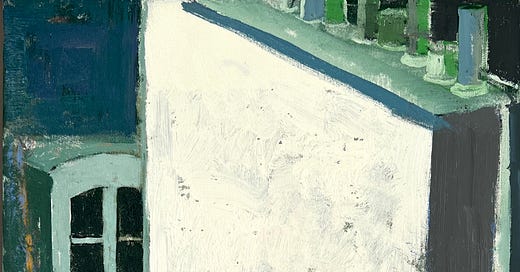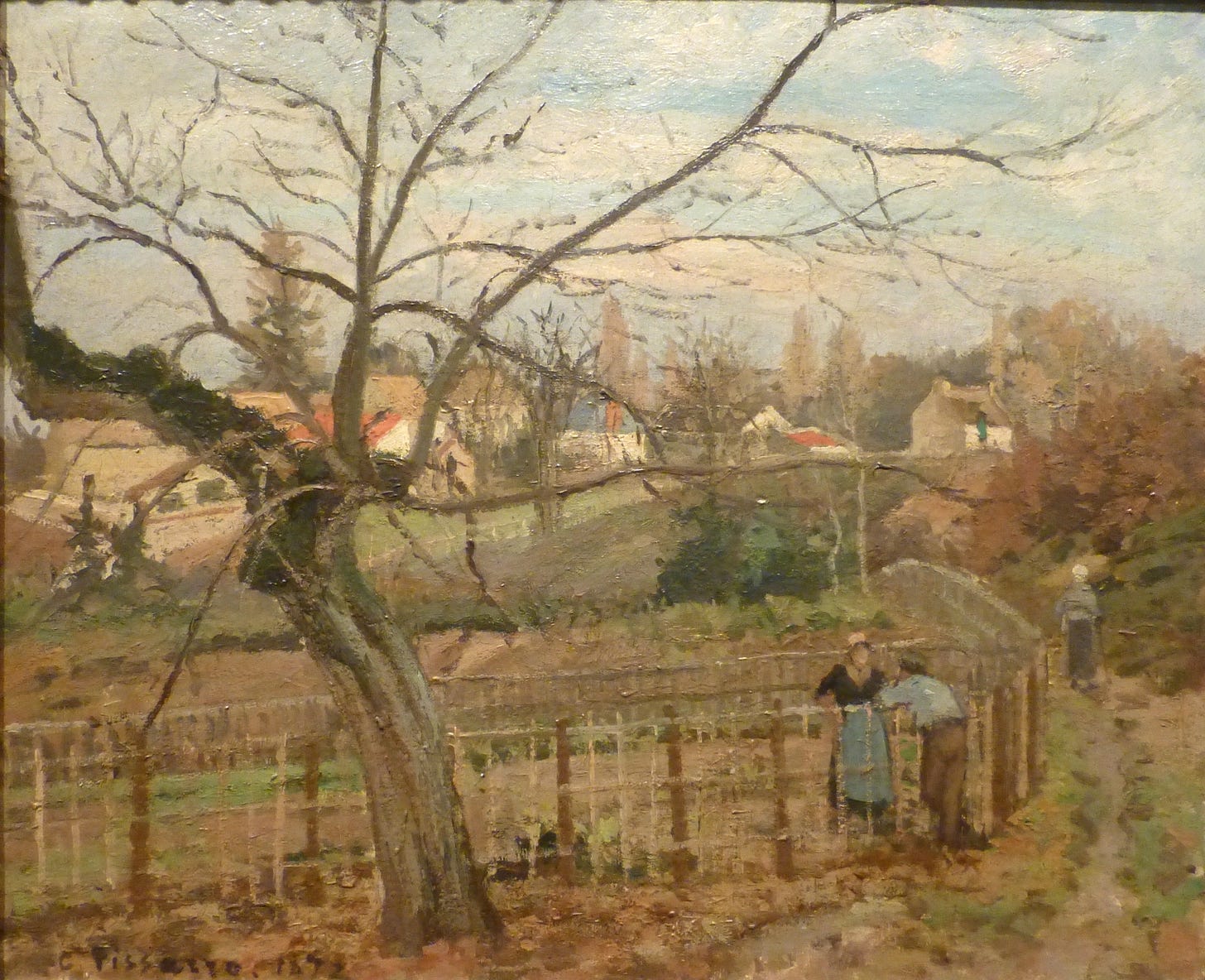"Cityscape, Landscape: Pissarro and My Father"
An essay by Luca Johnson on the occasion of Mitchell Johnson's Paris Exhibition
***Please note: Mitchell Johnson’s exhibition at Galerie Mercier in Paris has been extended through, Saturday, May 31.
Fences
A few times a week, my phone will buzz on my desk in the late afternoon with a text message from my father containing a new painting. I always pause my work, taking a moment to meditate on it. One work particularly caught my eye a few weeks ago — “Corn Hill (Albers).” The mystery of the fence and its ladder-like shadow moving into space pulled me in, and I continued to ponder it over the following days. He told me it took him nearly a year to complete and showed me the Josef Albers photograph of a fence from Mexico that inspired the composition. For me, however, with the idea of a fence in mind, the work recalled one of my father’s favorite paintings — “The Fence” by Camille Pissarro, housed at the National Gallery of Art in Washington, D.C. This 1872 work is a landscape of the French countryside featuring a fence snaking into the background of the canvas.
Those familiar with my father’s work are likely aware of the influence of Josef Albers and Giorgio Morandi; however, on the occasion of his exhibition at Galerie Mercier in Paris’ 7eme arrondissement, it is equally important to consider his work in the context of 19th- and 20th-century French painting. Before starting at Parsons in New York, Johnson spent two years working in Applied Research in Washington, D.C., spending his evenings taking classes at the Washington Studio School and volunteering as a docent at the National Gallery of Art. Before studying under leading postwar American artists Leland Bell, Paul Resika, Jane Freilicher, Larry Rivers and Robert De Niro, Sr. at Parsons in New York — and before visiting France for the first time — Johnson spent extensive time with the French paintings from the NGA’s renowned Mellon Collection.
When I was a child, my father and I made annual trips to Annapolis, Maryland, to visit my grandfather. Each year, the three of us made a pilgrimage to the National Gallery. My father guided us expertly through the maze of galleries, with our visit always culminating in a separate gallery in the West Building that housed the smaller Impressionist paintings donated by Paul Mellon. We looked closely at Bonnard and Vuillard before always pausing in front of “The Fence.” “This one is my favorite,” my dad would always say.
“The Fence” requires one to pause and look. Like “Corn Hill (Albers),” Pissarro uses the structure of the wooden fence as a visual invitation to lure the viewer into the composition. While for Johnson the fence draws us into its elusive morning shadow, Pissarro’s fence directs us to the path of the solitary figure to the right, encouraging us to look closer through the branches and appreciate the country houses illuminated in the background. Pissarro works the edges of the canvas – extending the path, branches, and fence to the borders of the composition – filling the space in a manner that reminds the viewer that every brush stroke and every detail is purposeful.
Pissarro painted this work in 1872 after returning to Pontoise from exile in England during the Franco-Prussian War. Prussian soldiers had occupied his atelier during the war, using his canvases as floor mats against the muddy country terrain, destroying much of the work he had left behind. On a symbolic level, “The Fence” feels like an ode to the innocence of country life that the Prussians violated — evident in the tender body language of the man leaning against the fence, head cradled in his palm, leg crossed nonchalantly. Pissarro was an outspoken anarchist throughout his life and, through his work, exhibited a deep reverence for the proletariat, rendering the everyday farmhand with the same respect that would be accorded to an aristocrat.
Pissarro’s depictions of the French countryside are predominantly from the Vallée de l’Oise — a collection of small towns in the northwestern environs of Paris, sitting along the Oise River. In November, 2024, I rode the RER A some 45 minutes outside the city to the town of Éragny. I walked along the banks of the Oise to Pontoise, finding a landscape largely unchanged from the late 19th-century scenes painted by Pissarro — the same willowy trees drooping into the water, the same factory sitting at a fork in the river.
I made the journey to the Vallée de l’Oise to experience the landscape and understand the space that shaped Pissarro’s vision, but also to appreciate the dichotomy between his provincial and Parisian existence. Pissarro struggled with his personal finances throughout his life and moved his family multiple times, at times relying on the monetary generosity of his good friend, Monet. On several occasions, when he came into a bit of money, he ventured into Paris, renting apartments steps from the Opéra, the Jardin des Tuileries, and the Pont Neuf. His Parisian existence always had a temporality — when his lease, money, or patience with the big city ran out, he would retreat to the countryside, the place where he felt truly at home. After an afternoon in the tranquility of the Vallée de l’Oise, the shock to the senses when stepping off the train at Gare Saint-Lazare is immediate.
A similar Parisian/provincial dichotomy also exists in my father’s career. Like Pissarro, he first engaged with France as an artist through her countryside before turning to Paris. My dad came to France for the first time in 1989, spending a few days in Paris before taking an overnight train to Marseille. He rented an apartment in the small town of Meyreuil from the village doctor and spent several months painting in the shadow of Mont Sainte-Victoire — the iconic flat-topped mountain ever-present in the work of Paul Cézanne. Before executing his iconic works near Aix-en-Provence, Cézanne spent years by Pissarro’s side on the banks of the Oise, mastering his sense of space and shape alongside one of the fathers of Impressionism.
My dad’s work from France was long centered around the landscapes of Meyreuil. Despite numerous visits to Paris in the decades following his first trip to Europe — staying in apartments across the city from Ménilmontant to the Marais to La Muette — it was not until the fall of 2021 that he first truly took interest in making compositions from Paris. Staying on Rue de Colisée in the 8eme, he spent hours at the window of a small apartment that looked out onto a Haussmannian courtyard, studying the dramatic slanted rooftops and the iconic tubular chimneys. During a two-week stay, he made his first canvases of Parisian rooftops and, several months later, began to take interest in the distinct green chairs in the Jardin du Luxembourg during his morning walks with my mother from an apartment at Port Royal.
Across some half-dozen two-week visits over the last four years, Johnson has continued to engage with the distinct Parisian setting. The ephemerality of these visits has, from my point of view, maintained his interest in the city, while the frequency of their occurrence allows him to continually peel back layers — to continually deepen his understanding of this space.
In “Paris (One Window),” a 2025 work on view this week at Galerie Mercier, there is a sensitivity and understanding of Paris — the result of years spent looking. Just as decades of visits to Truro inform the mystery of “Corn Hill,” so too does the repetition of regular Paris stays shape this new body of work. “Paris (One Window)” distills the rooftop into triangles and trapezoids. Johnson explores how shadows interact with the structure’s dramatic slant, as the Parisian rooftop — like the New England beach chair — becomes the medium, not the subject.
Pissarro and Johnson both embraced the challenge of exploring uniquely Parisian motifs and cityscapes without slipping into iconography or reportage. Pissarro was drawn to how the distinctly new Haussmannian structures and iconic parks transformed with light and the time of day — an approach echoed by my father, who remains fascinated by the shifting shadows cast across zinc rooftops and beneath the green metal chairs of the Jardin du Luxembourg. Both artists relied on their technique in dialogue with the qualities that define Paris, creating works that evoke the city’s essence while preserving what makes their own visions distinct. Their time in the countryside allowed them to find themselves as painters before entering the iconic and complex Parisian space, ensuring they never lost their sense of self or wonder amid the boulevards of one of the world’s most recognizable cities.
Having the opportunity to experience “Paris (One Window)” in person this week — alongside Johnson’s works from California, New England, and New York — is a testament to his ability to hold this duality: to capture the spirit of a place while keeping the focus on the central elements of color, light, and shape.
-Luca Johnson, Paris, May 22, 2025
EXHIBITION NEWS
“Giant Paintings from New England, California and Newfoundland”will be on view at 425 Market Street in San Francisco, March 17-May, 30, 2025.
Exhibition “Small Paintings” at Galerie Mercier, Paris, May 20-31, 2025. Reception Saturday, May 24, 4-6pm. (I’ll be at the gallery.)
Group show at The Glass House Fundraiser in New Canaan in June 14.
Group show at Cape Cod Museum of Art in Dennis, MA in May-July.
September solo exhibition at Truro Center for the Arts, Truro, MA.
Click here to see all of the new notecards including Paris, San Francisco, Amalfi, Newfoundland, Race Point, North Truro, Maine.
Notecards are also available in person at Explore Booksellers in Aspen, Keplers Booksin Menlo Park, Provincetown Art Association and Museum, SFMOMA, University ArtIn Redwood City, Book Passage (San Francisco and Corte Madera), The Cape Cod Museum of Art, Browser Books in San Francisco, Botanica, Truro General Store, Provincetown General Store, Print, Portland Maine and SF Mercantile.







Wonderfully written, this took me out of busy routine and into another place and time. You have both your parents’ talents and more!
Dear Luca,
Reading Fences was a moving experience — a beautiful, deeply felt tribute not only to your father’s artistry, but to the enduring, intimate connection you share with him. You capture so eloquently the quiet power of Mitchell’s work: how it invites contemplation, how it draws the viewer in with its atmospheric sensitivity and unerring attention to detail.
I was especially struck by your reflection on how a painting like Corn Hill (Albers) lives in the mind long after the first glance — that subtle, ladder-like shadow is such a perfect metaphor for how his paintings linger, lead us somewhere, and open into something greater. You articulate the way he distills essence from each place he paints — not as a chronicler, but as someone in constant dialogue with light, shape, and memory. It’s an approach that elevates the specific into something timeless.
Your writing is more than thoughtful commentary — it’s a love letter, quiet and profound, to your father and to the life of looking that you’ve shared with him. Thank you for letting us see him through your eyes.
Chloë